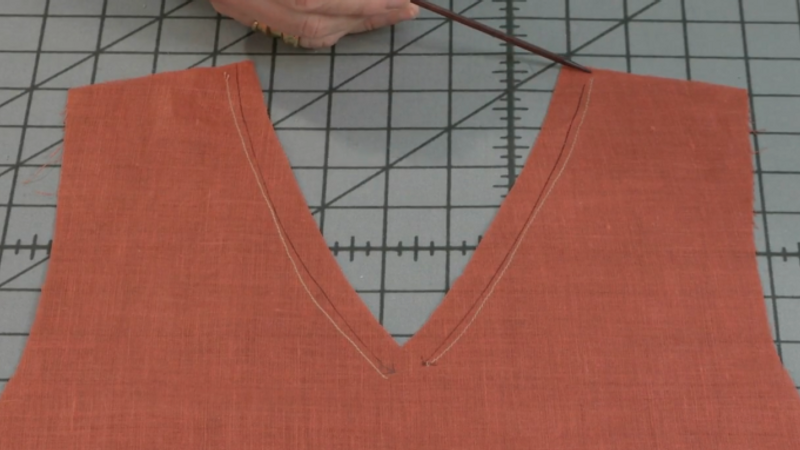
Staystitching is an often overlooked or avoided step in garment construction. Louise Cutting, a Threads contributing editor, reminds us of the importance of staystitching. This row of straight stitching, applied along curved or bias seamlines, prevents or minimizes potential stretching, so garment sections don’t become distorted during the construction process.
The key to proper staystitching is the direction in which you sew. Place the staystitching 1/8 inch from the seamline, within the seam allowance. Stitch each garment side separately, observing the fabric grain as you go. Necklines, bias seamlines, waistlines, and even side seamlines benefit from staystitching.














































Louise:
I understand your rules of stitching with the grain to avoid stretching cut edges and mirroring the stitching on necklines.
However you stitched north to south on the side of the top but south to north on the side of the skirt. Why the difference? When the stitching line is exactly on the straight of grain what is the rule for stitching direction?
You stitched the armscye in one southward line. Is it ever worth staystitching the armscye (or other edge that is not mirrored) in 2 segments, both pointing toward the point where the seamline is on the straight of grain?
Lastly, should stay stitching always be applied from the fabric right side? As long as I sew with the direction of grain as you indicate, will it make a difference on a neckline if I staystitch one side from the fabric right side and the other side from the fabric wrong side?
I am unsure how close to the stitching line I should staystitch. You said about 1/8" away from the stitching line, so at the 1/2 " of a 5/8" seam line. Now when completing the neckline, after grading the seam, I guess I should NOT clip through the staystitching, right? I always have because I did not understand the purpose of staystitching.
user-7181116, once you've completed the sewing--attached a facing, for example--you can clip the staystitching when you're grading and clipping the seam allowances. The staystitching has done its job of stabilizing the seamline while the garment is being constructed, and it's safe to clip as needed.
Carol Fresia, Threads Senior Technical Editor
Hi, PlayinHooky,
Good questions!
When you staystitch, you generally want to stitch from higher to lower (as on a shoulder seam), or from wider to narrower. A neckline usually is stitched from the shoulder seam toward center front/back--that is, both high to low, and wide to narrow.
On a bodice side seam, wider to narrower is usually "south," from armscye toward the waist; this captures and stabilizes any waistline shaping. On some garments, the seam flares back out toward the hips, but not so dramatically that you need to stitch up from the hemline--although you could if you desire.
On a skirt, the side seam is narrower at the waist and wider at the hip, so you stitch up from the hemline, toward the narrower waistline.
For the armscye, you could certainly staystitch in two passes, from top to middle, and bottom to middle. It's not usually necessary, however.
If the seam is entirely on the straight grain, there isn't typically any reason to staystitch, unless your fabric is quite unstable. You can sew from either direction in that case. And you can sew from RS or WS. If the fabric has some sort of tricky surface texture that might be marred by running along the feed dogs, you might consider sewing it RS up (and vice versa if the presser foot damages the fabric).
If you have doubts about which way to staystitch, do some experimenting on fabric scraps to see which direction does the best job of stabilizing the seamlines.
One of the most important tips is to staystitch adjoining seams in the same direction. For example, if you staystitch the bodice front side seam from top to bottom, do the same for the bodice back. If you staystitch a neckline from the shoulder seam to the center, staystitch the corresponding facing that way, too. This helps ensure that the seamlines remain the same length.
Carol J. Fresia
Threads Senior Technical Editor
Louise, I remembered all the rules for direction of stay stitching that I was taught in 9th grade home ec,(over 50 yrs ago) but I cannot remember what stitch size to use. Alas, you didnt say! I have searched and both a small stitch size (1.5-1.8) and a large stitch size (2.5- 3.5) were suggested. From your explanation as to the purpose of stay stitching, I think I should use a smaller stitch, but want to make sure. Thank you for your help. Jojo Sewist
Louise says to use a stitch length that's suitable for the weight of the fabric. A short length--1.5 to 2.0 mm--would be fine for fine, lightweight silk or cotton. For a mid-weight linen, you can go up to 2.5 mm. Longer stitches might be called for in heavier, thicker fabrics. It's a good idea to test a few inches of staystitching on a scrap, so see if the stitch length puckers or otherwise distorts the seamline. If so, adjust the length until you get a smooth line of stitching and the fabric's edge doesn't stretch or contract.
Carol J. Fresia, Threads Senior Technical Editor
Thank you, so use a stitch length that is smaller than the length your are using for seaming, and of course all stitches based on the fabric wt. Did I understand you corectly? I truly appreciate being able to watch all these videos.
Jojo
The stitch length can be the same as what you would use for seaming, if that works for you. Louise's other note was to use 100 percent cotton thread. This minimizes puckering.
Carol
Sorry, new to stay stitching, do you leave the stitches in? I am assuming yes.
Yes, you're correct, you leave the staystitching in. In some cases you may end up clipping through them, but that's OK--they'll have stabilized the seamline for accurate stitching, and it is safe to clip through them on curved edges.
Carol Fresia, Threads Senior Technical Editor